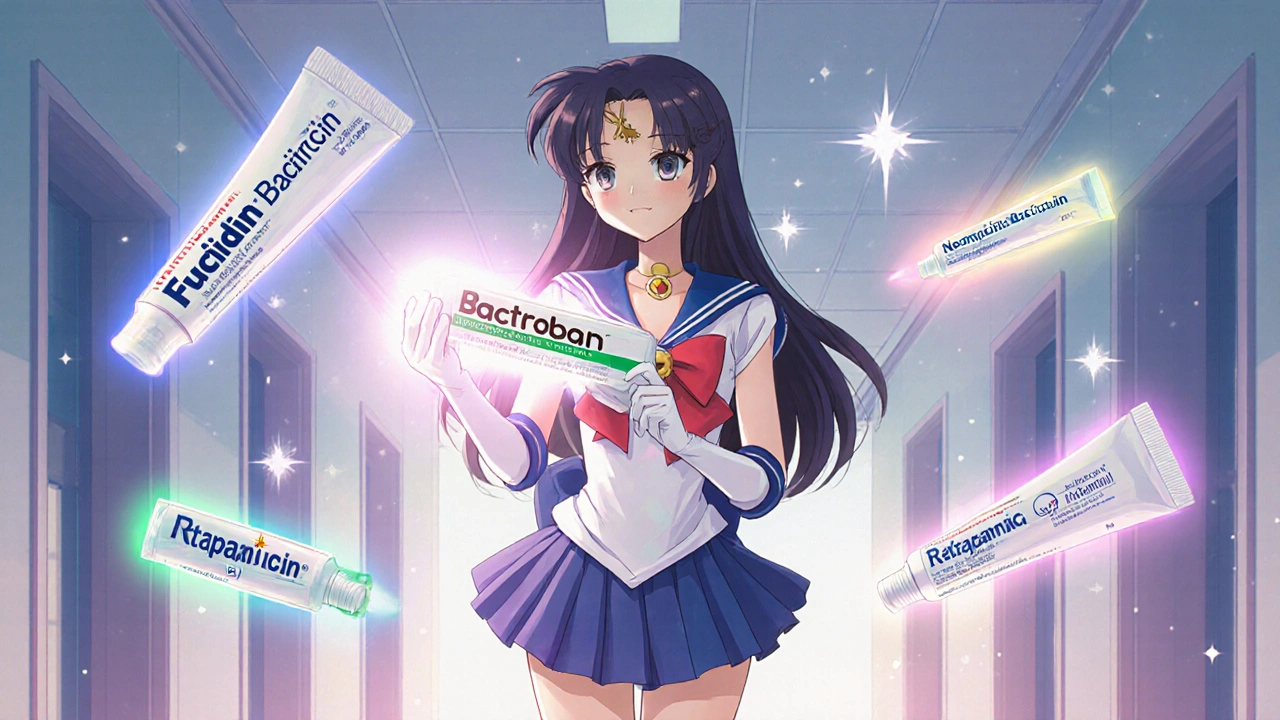Topical Antibiotic Selector
When a minor skin infection pops up, picking the right ointment can feel like a gamble. Bactroban is a household name, but dozens of other creams promise the same cure. This guide breaks down how Bactroban stacks up against the most common alternatives, so you can choose with confidence.
What is Bactroban Ointment?
Bactroban Ointment is a prescription‑only topical antibiotic that contains mupirocin, a naturally derived compound that blocks bacterial protein synthesis. It comes in a 5 g tube and is approved for treating impetigo, secondary infections of eczema, and small cuts or abrasions that show signs of infection.
How does mupirocin work?
Mupirocin binds to the bacterial isoleucyl‑tRNA synthetase enzyme, halting the production of essential proteins. This mechanism gives it a broad spectrum against Gram‑positive organisms, especially Staphylococcus aureus and Streptococcus pyogenes. Because it targets a specific step in protein synthesis, resistance develops slower than with many other topical agents.
Key criteria for comparing topical antibiotics
- Spectrum of activity: Which bugs does the drug kill?
- Resistance risk: How quickly do bacteria become immune?
- Typical indications: What skin conditions is it officially approved for?
- Cost and availability: Prescription vs. over‑the‑counter, price in NZ dollars.
- Side‑effect profile: Common irritation, allergic reactions, systemic absorption concerns.

Side‑by‑side comparison
| Product | Active ingredient | Primary spectrum | Typical use | Resistance risk | Cost (NZD) | OTC status |
|---|---|---|---|---|---|---|
| Bactroban | Mupirocin | Gram‑positive (incl. MRSA) | Impetigo, eczema‑related infection | Low (rare) | ~$25 per tube | Prescription |
| Fucidin | Fusidic acid a steroid‑derived antibacterial | Gram‑positive (Staph, Strep) | Minor cuts, infected eczema | Moderate (some resistance in Staph) | ~$12 per tube | Prescription |
| Neomycin‑Bacitracin | Neomycin & Bacitracin | Broad (Gram‑positive & some Gram‑negative) | Small abrasions, burns | High (neomycin allergy common) | ~$8 per tube | OTC |
| Retapamulin (Altabax) | Retapamulin a pleuromutilin‑type antibiotic | Gram‑positive (incl. MRSA) | Impetigo, superficial infection | Low (newer class) | ~$30 per tube | Prescription |
| Clindamycin Cream | Clindamycin lincosamide antibiotic | Gram‑positive, anaerobes | Acne, infected wounds | Moderate (C. difficile risk systemically) | ~$18 per tube | Prescription |
| Gentamicin Ointment | Gentamicin an aminoglycoside | Gram‑negative (Pseudomonas) & some Gram‑positive | Burns, deep wounds | Low (topical use limited) | ~$10 per tube | Prescription |
Deep dive into each alternative
Fusidic acid (Fucidin)
Fusidic acid is a steroid‑derived molecule that blocks bacterial protein synthesis at a different site than mupirocin. It’s especially effective against S. aureus but can lose potency if used repeatedly. In NZ, it’s prescribed for eczema‑related secondary infections and is cheaper than Bactroban, though the resistance trend is upward.
Neomycin‑Bacitracin combo
This over‑the‑counter blend offers a broad spectrum, but neomycin is a common allergen. Bacitracin adds coverage against staphylococci. Because the combo is readily available, patients sometimes overuse it, leading to irritant dermatitis. For mild abrasions it works fine, but it’s not the first choice for impetigo.
Retapamulin (Altabax)
Retapamulin is a newer pleuromutilin antibiotic. Its low resistance profile makes it attractive for MRSA‑susceptible skin infections. The price is higher, and insurance coverage can be spotty, but for short‑term use on impetigo it’s comparable to Bactroban in efficacy.
Clindamycin cream
Clindamycin’s strength lies in targeting anaerobic skin flora and acne‑related bacteria. It’s not a first‑line for impetigo, but when a mixed infection includes anaerobes, it can be useful. Systemic side effects are rare with topical use, yet clinicians watch for possible C. difficile colonisation in heavy users.
Gentamicin ointment
Gentamicin tackles Gram‑negative organisms that mupirocin can miss, such as Pseudomonas in burn wounds. Its poor skin penetration limits usefulness for superficial infections, but in deep or moist wounds it’s a solid adjunct.
How to decide which ointment fits your needs
- Identify the pathogen: If you suspect MRSA or classic impetigo, mupirocin or retapamulin are top picks.
- Check for allergies: Neomycin allergy rates hover around 10 % in the general population.
- Consider cost and access: For budget‑conscious patients, fusidic acid offers decent coverage at half the price of Bactroban.
- Evaluate infection depth: Superficial infections respond to mupirocin; deeper burns may need gentamicin.
- Review resistance trends: In settings with documented mupirocin resistance, switch to retapamulin or fusidic acid.
Safety profile and common side effects
Bactroban is generally well tolerated; the most frequent complaint is mild burning or itching at the application site. Fusidic acid can cause localized redness, while neomycin‑bacitracin is notorious for contact dermatitis. Retapamulin may cause a transient stinging sensation. Clindamycin sometimes leads to dry skin, and gentamicin can rarely cause systemic nephrotoxicity if large areas are covered for prolonged periods.
Quick reference checklist
- First‑line for impetigo: Bactroban or Retapamulin
- Best budget choice for mild infections: Fusidic acid
- OTC option for small cuts: Neomycin‑Bacitracin
- Ideal for burn‑related Gram‑negative risk: Gentamicin
- Avoid if known neomycin allergy: Neomycin‑Bacitracin
Frequently Asked Questions
Can I use Bactroban without a prescription?
In New Zealand, Bactroban is classified as prescription‑only. A doctor’s script is required to obtain it from a pharmacy.
How long should I apply Bactroban for impetigo?
Typical treatment lasts 5 days, applied three times daily. Continue the full course even if lesions look better.
Is there cross‑resistance between mupirocin and other topical antibiotics?
Cross‑resistance is uncommon because mupirocin targets a unique enzyme. However, widespread use of any antibiotic can select for resistant strains.
What should I do if I develop a rash after using Bactroban?
Stop the ointment and wash the area with mild soap and water. Contact your GP; they may switch you to a different topical agent.
Are there any age restrictions for mupirocin?
Mupirocin is approved for use in children over 2 months old. For infants younger than that, physicians usually choose bacitracin or a bland moisturizer.

Drew Waggoner
October 18, 2025 AT 19:50I feel like every new ointment hype just adds another layer of confusion, and it's exhausting to keep up with the endless options.
Mike Hamilton
October 22, 2025 AT 18:20Well, u kno, they all kinda do the same job but some are cheaper. It helps to look at the list and see what ur wallet can handle.
Matthew Miller
October 26, 2025 AT 18:33When you stare at a shelf full of shiny tubes, the mind can start to wander like a sailor lost at sea.
Mupirocin, the star of Bactroban, feels like the seasoned captain who knows every hidden reef.
Its ability to hijack bacterial protein synthesis is as clever as a thief picking a lock in the dead of night.
Yet the newer retapamulin steps onto the deck with a fresh breeze, promising low resistance like an untouched island.
Fusidic acid, meanwhile, is the budget-friendly deckhand who still gets the job done without demanding a royal fee.
The neomycin‑bacitracin combo is the chaotic crowd‑source crew, covering a broad spectrum but prone to causing skin riots.
Clindamycin, with its anaerobic prowess, sneaks into the deeper pockets of infection like a stealthy ninja.
Gentamicin brings the heavy artillery, aiming at Gram‑negative invaders that the others might miss.
Cost considerations are the tide that lifts all boats, and in New Zealand dollars the price gap can be the decisive factor.
Prescription status acts as a gatekeeper, sometimes keeping the most effective agents locked away from casual sailors.
Allergic reactions are the hidden reefs; a single misstep can leave a skin wound with a painful scar.
Resistance patterns evolve like shifting sands, reminding us that overuse can erode even the strongest defenses.
For a simple cut on a kid’s knee, the over‑the‑counter neomycin‑bacitracin may be sufficient, sparing the wallet and the paperwork.
But for stubborn impetigo that refuses to fade, the laser‑sharp focus of mupirocin or retapamulin shines through.
In the end, the best choice is a balanced compass guided by the infection’s type, the patient’s history, and the pocket’s depth.
Bethany Torkelson
October 30, 2025 AT 19:46Enough with the poetic fluff-if you want fast relief, just pick Bactroban. It’s proven, it’s potent, and it cuts through infection like a blade.
Grace Hada
November 3, 2025 AT 21:00Stop romanticizing ointments; use the one with proven MRSA coverage.
alex montana
November 7, 2025 AT 22:13Look-Bactroban is great!!! but cost???; still worth it.
Wyatt Schwindt
November 11, 2025 AT 23:26It’s helpful to match the ointment to the infection depth and any known allergies.
Fabian Märkl
November 16, 2025 AT 00:40Absolutely! 😊 Choosing the right cream can make a huge difference.
Natala Storczyk
November 20, 2025 AT 01:53Honestly, the market is flooded with mediocre medi‑cine-only Bactroban stands tall, defying the weak imitators!!!
Linda A
November 24, 2025 AT 03:06The quest for the perfect topical agent mirrors humanity’s endless search for certainty. Each cream carries a story of chemistry, commerce, and compromise. Yet the skin’s response remains the ultimate judge.
Joe Moore
November 28, 2025 AT 04:20Yo, they dont tell ya that big pharma pushes Bactroban to keep the cheaper stuff outta sight. It's all a money game.
Poornima Ganesan
December 2, 2025 AT 05:33When evaluating topical antibiotics, one must consider pharmacodynamics, local tissue penetration, and the prevailing resistance data in the region. Bactroban’s low resistance profile stems from its unique target, but overuse can still select for mupirocin‑resistant strains. Fusidic acid, while cheaper, shows an upward trend in resistance among Staphylococcus aureus isolates in New Zealand. Neomycin‑bacitracin offers broad coverage but carries a high risk of contact dermatitis, especially in sensitized individuals. Ultimately, the clinician’s judgment should integrate both microbiological evidence and patient-specific factors.
Emma Williams
December 6, 2025 AT 06:46Agreed, balancing efficacy and safety is key.
Stephanie Zaragoza
December 10, 2025 AT 08:00Indeed-while Bactroban provides excellent coverage for Gram‑positive organisms, clinicians must remain vigilant; the emergence of mupirocin‑resistant strains, though currently uncommon, warrants periodic surveillance and judicious prescribing practices.
James Mali
December 14, 2025 AT 09:13Sounds like a lot of hype for a small tube.